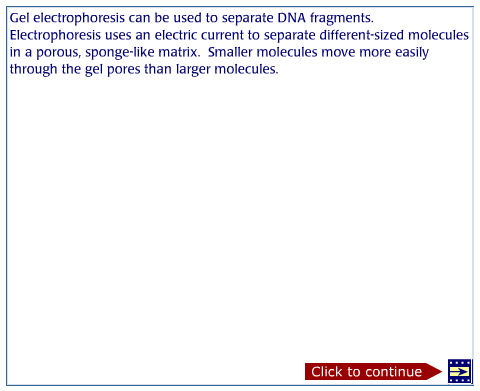Author:
Matthew Robbins, The Ohio State University
Introduction
Gel electrophoresis is commonly used in plant breeding and genomics for genotyping with molecular markers, but there are several other applications as well (see below). For example, specific DNA fragments used as markers and isolated from individual plants are amplified by the polymerase chain reaction (PCR) and the resulting DNA fragments are subsequently loaded on a gel. The gel is a solid, gelatin-like substance used to separate DNA fragments based on size. The gel is placed in a conductive salt buffer to which an electrical field is applied. As the negatively-charged DNA fragments migrate toward the positive pole, the gel acts as a size filter, with smaller fragments migrating faster than larger fragments.
Resources on Gel Electrophoresis
In addition, this video illustrates the basics of DNA extraction and gel electrophoresis in tomato:
The Plant and Soil Sciences eLibrary at the University of Nebraska-Lincoln has an informative lesson on gel electrophoresis, including an animation of the process:

Photo credit: Plant and Soil Sciences eLibrary
Another animation on gel electrophoresis can be found at the Dolan DNA Learning Center, part of The Cold Spring Harbor Laboratory:

Photo credit: The Dolan DNA Learning Center
The Genetics Science Learning Center at the University of Utah also has an animation on gel electrophoresis:

Photo credit: The Genetics Science Learning Center
Applications of Gel Electrophoresis
DNA can be separated by electrophoresis to:
- Visualize bands of a molecular marker to genotype individual plants
- Verify amplification by PCR or sequencing reactions
- Check the quality and quantity of genomic DNA after DNA extraction
- Separate DNA fragments to clone a specific band
External Links
- Gel electrophoresis [Online animation]. Dolan DNA Learning Center, Cold Springs Harbor Laboratory. Available at: www.dnalc.org/resources/animations/gelelectrophoresis.html (verified 31 May 2012).
- Gel electrophoresis virtual lab [Online animation]. Genetic Science Learning Center, University of Utah. Available at: learn.genetics.utah.edu/content/labs/gel/ (verified 31 May 2012).
- Lee, D. and P. Hain. Electrophoresis: How scientists observe fragments of DNA [Online lesson]. Plant and Soil Sciences eLibrary. University of Nebraska – Lincoln. Available at: http://plantandsoil.unl.edu/croptechnology2005/pages/index.jsp?what=topicsD&topicOrder=1&informationModuleId=1065724861 (verified 24 Sept 2010).
- Talpallikar, V., D. Lee, and P. Hain. 2000. Gell electrophoresis [Online animation]. Plant and Soil Sciences eLibrary. University of Nebraska – Lincoln. Available at: http://plantandsoil.unl.edu/croptechnology2005/pages/animationOut.cgi?anim_name=Gel_electrophoresis.swf (verified 7 Dec 2010).
Additional Resources
- Wikipedia Contributors. 2010. Gel electrophoresis. Wikipedia, The Free Encyclopedia. Available at: http://en.wikipedia.org/w/index.php?title=Gel_electrophoresis&oldid=397218980 (verified 31 May 2012).
Funding Statement
Development of this lesson was supported in part by the National Institute of Food and Agriculture (NIFA) Solanaceae Coordinated Agricultural Project, agreement 2009-85606-05673, administered by Michigan State University. Any opinions, findings, conclusions, or recommendations expressed in this publication are those of the author(s) and do not necessarily reflect the view of the United States Department of Agriculture.
PBGworks 654
